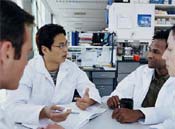RESEARCH AND MARKET EXPRESS
Vitamin D & Breast Cancer Prevention
Peter Ou, Ph.D. VitaminD-or the dairy foods that often supply it-may help cut the risk of breast cancer in postmenopausal women.Researchers at the American Cancer Society tracked more than 68,000 women in the Cancer Prevention Study. After nearly a decade, those who got more vitamin D or ate more dairy foods had a lower risk of estrogenpositive breast cancer, but only if they lived in the northern half of the country, which gets little or no ultraviolet light from the sun in the winter.
In those areas, women who consumed the most vitamin D from their food (more than 300 IU a day) had a 20 percent lower risk of postmenopausal breast cancer than women who consumed the least vitamin D (100 IU or less). And women who averaged at least two low-fat dairy foods a day (usually low-fat milk) had a 23 percent lower risk than those who averaged less than half a serving a day.
Vitamin D and dairy foods had no impact on women from southern states, presumably because they get enough vitamin D from the sun's UV light year-round. (The sun's ultraviolet rays are strongest at the equator, and weaken as you go north or south from there.)
What to do: Researchers don't yet know if vitamin D or dairy foods lower the risk of breast cancer. But it's worth getting enough of both to protect your bones. (Bonus: two or three servings a day of low-fat dairy can also help lower blood pressure.)
You can get vitamin D from the sun, from milk and other fortified foods, and from multivitamins. Aim for 200 IU a day if you're 50 or under, 400 IU a day if you're 51 to 70, and at least 600 IU a day (some experts recommend 1,000 IU if you get no sun) if you're over 70.
(Published: )
Go back
